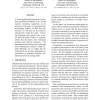Free Online Productivity Tools
i2Speak
i2Symbol
i2OCR
iTex2Img
iWeb2Print
iWeb2Shot
i2Type
iPdf2Split
iPdf2Merge
i2Bopomofo
i2Arabic
i2Style
i2Image
i2PDF
iLatex2Rtf
Sci2ools
ACL
2015
2015
Orthogonality of Syntax and Semantics within Distributional Spaces
A recent distributional approach to wordanalogy problems (Mikolov et al., 2013b) exploits interesting regularities in the structure of the space of representations. Investigating further, we find that performance on this task can be related to orthogonality within the space. Explicitly designing such structure into a neural network model results in representations that decompose into orthogonal semantic and syntactic subspaces. We demonstrate that learning from word-order and morphological structure within English Wikipedia text to enable this decomposition can produce substantial improvements on semantic-similarity, posinduction and word-analogy tasks.
Related Content
| Added | 13 Apr 2016 |
| Updated | 13 Apr 2016 |
| Type | Journal |
| Year | 2015 |
| Where | ACL |
| Authors | Jeff Mitchell, Mark Steedman |
Comments (0)

